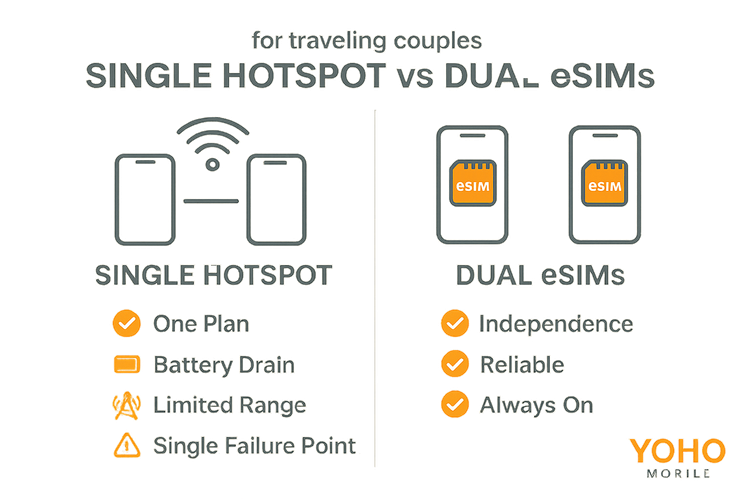¿Hotspot o dos eSIM? La mejor forma para que las parejas se mantengan conectadas
Bruce Li•Sep 19, 2025
Viajar con tu pareja consiste en crear recuerdos compartidos, no en separarse porque uno se ha alejado del alcance del Wi-Fi. Al planificar su escapada romántica, un elemento tecnológico de viaje crucial a considerar es cómo se mantendrán ambos conectados. La gran pregunta a menudo se reduce a esto: ¿deberían comprar un gran plan de datos y compartirlo a través de un hotspot móvil, o cada uno debería obtener una eSIM por separado?
La respuesta depende de su estilo de viaje, destino y presupuesto. Analicemos los pros y los contras de cada enfoque para encontrar la solución de conectividad de viaje perfecta para ustedes.
¿Listos para encontrar su plan perfecto? Con los planes de eSIM flexibles de Yoho Mobile, pueden personalizar los datos para cualquier viaje, asegurando que usted y su pareja se mantengan conectados sin arruinarse.
La estrategia de un solo hotspot: ¿Un plan para gobernarlos a todos?
Depender del hotspot móvil de un solo teléfono es una opción popular para compartir datos entre parejas en viajes internacionales. Compras un único paquete de datos grande y conectas el segundo dispositivo. Parece simple, pero conlleva importantes desventajas.
Pros:
- Simplicidad: Solo necesitas comprar y gestionar un plan.
- Ahorro potencial de costos: A veces, un plan de datos grande puede ser más barato que dos más pequeños.
Contras:
- Consumo masivo de batería: Usar un hotspot móvil es una de las formas más rápidas de agotar la batería de un teléfono. Como señalan los expertos en tecnología de publicaciones como PCMag, el anclaje de red (tethering) consume una cantidad significativa de energía, dejando tu teléfono “hotspot” sin batería cuando más lo necesitas.
- La correa de la proximidad: Deben permanecer cerca de la persona que tiene el teléfono con el hotspot. Si quieren separarse para explorar diferentes tiendas o uno de ustedes regresa al hotel, la otra persona se queda sin internet.
- Punto único de fallo: Si el teléfono con el hotspot se pierde, es robado o se rompe, ambos se quedan sin conexión. Esto puede ser un problema importante en un país desconocido.
- Velocidades reducidas: Compartir una conexión puede ralentizar la velocidad de internet para ambos usuarios, especialmente si ambos están transmitiendo videos o subiendo fotos.

El poder de dos: Por qué las eSIM duales cambian las reglas del juego
Equipar a cada miembro de la pareja con su propia eSIM (SIM integrada) es una alternativa cada vez más popular y poderosa. Una eSIM es una SIM digital que te permite activar un plan de telefonía móvil sin necesidad de usar una tarjeta SIM física. Antes de viajar, asegúrate de verificar si tus dispositivos están en la lista de compatibles con eSIM.
Pros:
- Independencia total: Cada persona tiene su propia conexión de datos fiable. Pueden separarse para dedicarse a diferentes intereses y reunirse más tarde sin interrupciones en la comunicación.
- Fiabilidad mejorada: Con dos conexiones separadas, tienen un respaldo incorporado. Si una persona tiene mala cobertura en un lugar específico, la otra aún podría estar conectada.
- Sin problemas de consumo de batería: Sin la necesidad de un hotspot constante, las baterías de ambos teléfonos durarán mucho más durante un día de exploración.
- Rendimiento optimizado: Cada usuario obtiene la velocidad completa de su plan de datos, lo que lleva a una experiencia más fluida para la navegación, las redes sociales y las videollamadas.
Contras:
- Gestionar dos planes: Tendrán que comprar e instalar dos planes por separado, aunque con Yoho Mobile, este proceso es increíblemente simple.
Para los usuarios de iOS, Yoho Mobile lo hace aún más fácil: después de la compra, simplemente pulsen el botón ‘Instalar’ para ser guiados a través de la configuración del sistema en menos de un minuto, sin necesidad de códigos QR o códigos de activación manual. Los usuarios de Android aún pueden usar el método rápido del código QR.
Análisis de escenarios: ¿Cuál es el mejor plan móvil para parejas que viajan?
Entonces, ¿es mejor usar un hotspot o tener dos eSIM? La mejor elección depende de su itinerario.

Para los exploradores urbanos en Japón
Imagina que estás navegando por las bulliciosas calles de Tokio. Uno de ustedes quiere visitar el sereno Santuario Meiji mientras que el otro busca vinilos raros en Shinjuku. Con dos eSIM separadas, pueden seguir caminos distintos fácilmente y usar Google Maps para reunirse más tarde a comer ramen. Un hotspot compartido sería increíblemente restrictivo aquí.
Veredicto: Dos eSIM. Explora los planes eSIM de Yoho Mobile para Japón para una exploración ininterrumpida.
Para los buscadores de aventuras en Europa
Imagínense haciendo senderismo en los Alpes suizos o explorando la costa de Portugal. ¿Qué pasaría si uno de ustedes se tuerce un tobillo y necesita descansar mientras el otro va a buscar ayuda? Tener dos líneas de comunicación independientes no es solo una comodidad, es una medida de seguridad. El alcance limitado de un hotspot podría ser un problema real al aire libre.
Veredicto: Dos eSIM. Manténganse seguros y conectados con nuestros paquetes de datos eSIM para toda Europa.
Para los mochileros con presupuesto ajustado en Tailandia
Si viajan con un presupuesto ajustado y planean estar juntos el 99% del tiempo, un hotspot podría funcionar. Sin embargo, con la asequibilidad de las eSIM modernas, la diferencia de costo suele ser mínima. Por solo unos pocos dólares más, la libertad y fiabilidad de dos planes casi siempre valen la pena. Además, nunca se sabe cuándo necesitarán hacer un trámite de visa o un recado por separado.
Veredicto: Las eSIM duales siguen siendo muy recomendables por la flexibilidad. ¿No estás seguro? ¿Por qué no obtener una eSIM de prueba gratuita de Yoho Mobile para probar el servicio antes de comprometerte?
La solución de Yoho Mobile: Conexión sin compromisos
En Yoho Mobile, creemos que la conectividad en los viajes debe ser flexible y sin preocupaciones. Por eso defendemos el enfoque de doble eSIM para las parejas.
- Planes flexibles: No pagues por lo que no necesitas. Con nuestros planes de eSIM de viaje flexibles, tú y tu pareja pueden elegir la cantidad perfecta de datos para sus necesidades individuales.
- Protección Yoho Care: ¿Te preocupa quedarte sin datos en un momento crítico? Con Yoho Care, nunca estás realmente desconectado. Incluso si tu paquete de datos se agota, te proporcionamos una conexión de respaldo para asegurar que siempre puedan comunicarse entre ustedes o pedir ayuda.
Con Yoho Mobile, obtienes la libertad de planes separados con la tranquilidad de estar siempre conectado, pase lo que pase.
Preguntas frecuentes (FAQ)
P: ¿Es más barato compartir un hotspot o comprar dos eSIM?
R: Aunque un único plan de datos grande a veces puede parecer más barato de entrada, la diferencia de costo para dos eSIM separadas de tamaño adecuado de un proveedor asequible como Yoho Mobile suele ser insignificante. Cuando se tienen en cuenta la comodidad, la fiabilidad y el ahorro de batería, dos eSIM casi siempre ofrecen un mejor valor general para las parejas que viajan.
P: ¿Usar un hotspot móvil consume muchos datos?
R: El hotspot en sí no consume datos adicionales, pero permite que otro dispositivo use tu plan de datos. Si tu pareja está transmitiendo videos o haciendo videollamadas a través de tu hotspot, puede agotar tu asignación de datos muy rápidamente. Esta es una consideración clave al decidir sobre el uso compartido de datos para parejas durante viajes internacionales.
P: ¿Podemos ambos usar internet al mismo tiempo con un hotspot?
R: Sí, pero la velocidad de tu conexión se dividirá entre ambos dispositivos. Esto puede provocar tiempos de carga lentos, videos que se pausan y frustración para ambos usuarios. Dos eSIM separadas aseguran que ambos miembros de la pareja obtengan la máxima velocidad disponible en sus planes individuales.
P: ¿Cómo ahorramos en cargos de roaming como pareja?
R: La mejor manera de ahorrar en cargos de roaming es evitarlos por completo usando eSIM de viaje. En lugar de pagar tarifas exorbitantes de tu operador de origen, puedes comprar un plan de datos local y asequible para tu destino. Obtener una eSIM para cada persona es la estrategia más efectiva para mantener los costos bajos y la conectividad alta. Para más información sobre la tecnología eSIM, puedes consultar recursos de la GSMA.
Conclusión: Dos es mejor que uno
Para la gran mayoría de las parejas que viajan, el veredicto es claro: dos eSIM separadas ofrecen una libertad, fiabilidad y tranquilidad superiores en comparación con un único hotspot compartido. La ligera comodidad de gestionar un solo plan se ve ampliamente superada por las desventajas del consumo de batería, el alcance limitado y tener un único punto de fallo.
Regálense una conectividad sin estrés en su próxima aventura. Exploren hoy los planes de eSIM flexibles y asequibles de Yoho Mobile y vivan la experiencia de viajar como debe ser: juntos, pero con la libertad de explorar de forma independiente.
